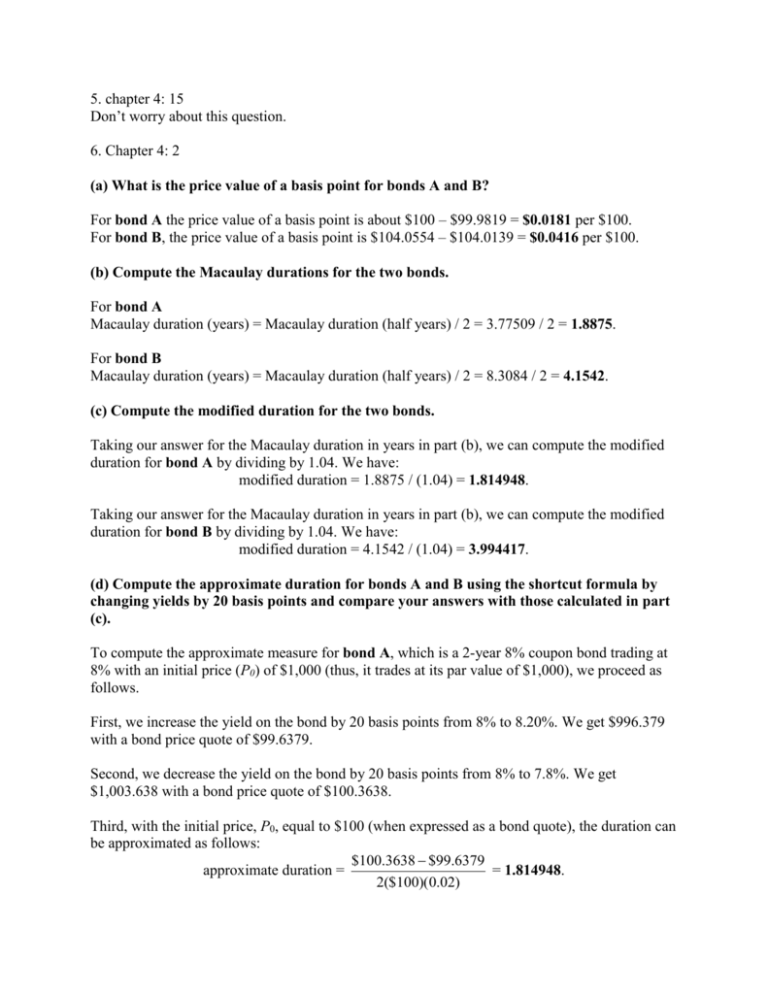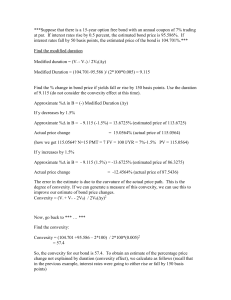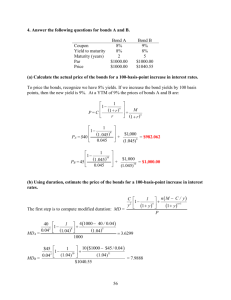Bond Valuation Problems & Solutions: Duration & Convexity
advertisement

5. chapter 4: 15 Don’t worry about this question. 6. Chapter 4: 2 (a) What is the price value of a basis point for bonds A and B? For bond A the price value of a basis point is about $100 – $99.9819 = $0.0181 per $100. For bond B, the price value of a basis point is $104.0554 – $104.0139 = $0.0416 per $100. (b) Compute the Macaulay durations for the two bonds. For bond A Macaulay duration (years) = Macaulay duration (half years) / 2 = 3.77509 / 2 = 1.8875. For bond B Macaulay duration (years) = Macaulay duration (half years) / 2 = 8.3084 / 2 = 4.1542. (c) Compute the modified duration for the two bonds. Taking our answer for the Macaulay duration in years in part (b), we can compute the modified duration for bond A by dividing by 1.04. We have: modified duration = 1.8875 / (1.04) = 1.814948. Taking our answer for the Macaulay duration in years in part (b), we can compute the modified duration for bond B by dividing by 1.04. We have: modified duration = 4.1542 / (1.04) = 3.994417. (d) Compute the approximate duration for bonds A and B using the shortcut formula by changing yields by 20 basis points and compare your answers with those calculated in part (c). To compute the approximate measure for bond A, which is a 2-year 8% coupon bond trading at 8% with an initial price (P0) of $1,000 (thus, it trades at its par value of $1,000), we proceed as follows. First, we increase the yield on the bond by 20 basis points from 8% to 8.20%. We get $996.379 with a bond price quote of $99.6379. Second, we decrease the yield on the bond by 20 basis points from 8% to 7.8%. We get $1,003.638 with a bond price quote of $100.3638. Third, with the initial price, P0, equal to $100 (when expressed as a bond quote), the duration can be approximated as follows: $100.3638 $99.6379 approximate duration = = 1.814948. 2($100)(0.02) This compares with 1.814948 computed in part (c). Thus, the approximate duration measure is virtually the same as the modified duration computed in part (c). To compute the approximate measure for bond B, which is a 5-year 9% coupon bond trading at 8% with an initial price (P0) of $104.0554, we have the following: approximate duration = $104.8909 $103.2283 = 3.994400. 2($104.0554)(0.02) This compares with 3.994417 computed in part (c). Thus, the approximate duration measure is virtually the same as the modified duration computed in part (c). (e) Compute the convexity measure for both bonds A and B. For bond A, we have a 2-year, 8% coupon bond trading at 8% with an initial price (P0) of $1,000 with a bond quote of $100. Expressing numbers in terms of a $100 bond quote, we have: C = $4, y = 0.04, n = 4 and P = $100. Inserting these numbers into our convexity measure formula gives: convexity measure (half years) = 2($4) 4(5) 100 $4 / 0.04 1 1 2($4)4 1 3 4 5 6 = (0.04) 1.04 (0.04) 2 1.04 $100 1.04 1 [$125,000[0.14519581] – 16,438.54214 + $0] = 1,710.93[0.01] = 17.109354. $100 Convexity measure (years) = convexity measure (half years) / 4 = 17.1093 / 4 = 4.2773350. For bond B, we have a 5-year 9% coupon bond trading at 8% with an initial price (P0) of $104.055. Expressing numbers in terms of a $100 bond quote, we have: C = $4.5, y = 0.04, n = 10, and P = $104.0554. Inserting these numbers into our convexity measure formula gives: Convexity measure (years) = 19.7636077. (f) Compute the approximate convexity measure for bonds A and B using the shortcut formula by changing yields by 20 basis points and compare your answers to the convexity measure calculated in part (e). To compute the approximate convexity measure for bond A, which is a 2-year 8% coupon bond trading at 8% with an initial price (P0) of $100, we proceed as follows. First, we increase the yield on the bond by 20 basis points from 8% to 8.2%. Thus, ∆y is 0.002. The new price (P+) can be computed using our bond valuation formula. Doing this we get $99.6379. Second, we decrease the yield on the bond by 20 basis points from 8% to 7.8%. The new price (P_) can be computed using our bond valuation formula. Doing this we get $1,003.638 with a bond price quote of $100.3638. Third, with the initial price, P0, equal to $100, the convexity measure of any bond can be approximated using the following formula: Inserting in our values, the approximate convexity measure is approximate convexity measure = $100.3638 $99.6379 2($100) $100(0.002) 2 = 4.2773486. This answer of 4.2773486 for the approximate convexity measure is very similar to that computed in part (e) using the convexity measure where we got 4.2773350. For bond B, approximate convexity measure = $104.8909 $103.2283 2($104.0554) = 19.763824. 2 $104.0554(0.002) This answer of 4.2773486 for the approximate convexity measure is very similar to that computed in part (e) using the convexity measure where we got 19.7636077. 7. Chapter 4: 4 (a) Calculate the actual price of the bonds for a 100-basis-point increase in interest rates. For bond A, P = $982.062. For bond B, P = $1,000.00. (b) Using duration, estimate the price of the bonds for a 100-basis-point increase in interest rates. For bond A, dP = –modified duration (dy) = –1.805159(0.01) = –0.0180515. P We can now solve for the new price of bond A as shown below: dP 1 P = (1 +( –0.0180515)$1,000 = (0.9819484)$1,000 = $981.948. P This is slightly less than the actual price of $982.062. The difference is $982.062 – $981.948 = $0.114. For bond B, dP = –modified duration (dy) = –3.956359(0.01) = –0.0395635. P dP ) P = (1 – 0.0395635)$1,040.55 = (0.9604364)$1,040.55 = P $999.382. This is slightly less than the actual price of $1,000. The difference is $1,000 – $999.382 = $0.618. Thus, the new price is (1 (c) Using both duration and convexity measure, estimate the price of the bonds for a 100basis-point increase in interest rates. For bond A, we use the duration and convexity measures. We will now estimate the price by first approximating the dollar price change. With 100 basis points giving dy = 0.01 and a modified duration computed in part (b) of 1.805159, we have: dP = –modified duration (dy) = –1.805159(0.01) = –0.01805159 or about –1.805159%. P Next, we consider convexity, the convexity measure (years) = 4.233125. dP 1 convexity measure (dy)2. Inserting in The percentage price change due to convexity is: P 2 dP 1 (4.233125) (0.01)2 = 0.00021166. Thus, we have 0.021166% increase our values, we get: P 2 in price when we adjust for the convexity measure. Adding the duration measure and the convexity measure, we get –1.805159% + 0.021166% = – 1.783994%. dP new price is 1 P = (1 +( – 0.01783994)$1,000 = (0.9819484)$1,000 = $982.160. P For bond B, we can also estimate its price using both the duration and convexity measures as just shown for bond A. dP = –modified duration (dy) = –3.956359(0.01) = –0.0395635 or about –3.95635%. P Next, we consider the convexity. The convexity measure (years) = 19.452564. The percentage price change due to convexity is: our values, we get: dP 1 convexity measure (dy)2. Inserting in P 2 dP 1 (19.452564) (0.01)2 = 0.00097463. P 2 Adding the duration measure and the convexity measure, we get –3.956359% + 0.097263% equals –3.859096%. Recall the actual change in price is: ($1,000 – $1,040.55) = −$40.55 and the actual percentage change in price is: –$40.55 / $1,040.55 = −0.0389697 or about −3.896978%. Thus, the new price is (1 dP ) P = (1 – 0.03859096)$1,040.55 = (0.9614091)$1,040.55 = P $1,000.394 for bond A. (d) Comment on the accuracy of your results in parts b and c, and state why one approximation is closer to the actual price than the other. The estimation is more accurate with considering convexity. Use your own words to explain. (e) Without working through calculations, indicate whether the duration of the two bonds would be higher or lower if the yield to maturity is 10% rather than 8%. Interest rate risk is greater when yield is lowered. 8. Chapter 4: 17 (a) What is the portfolio’s duration? (Ww)Dw + (Wx)Dx + (Wy)Dy + (Wz)Dz = (13/140)2 + (27/140)7 + (3/7)8 + (2/7)14 = 0.1857142 + 1.350000 + 3.4285714 + 4.0000 = 8.9643 or about 9 years. (b) If interest rates for all maturities change by 50 basis points, what is the approximate percentage change in the value of the portfolio? dP = –(modified duration)(dy) = –(8.9643)(0.005) = –0.0448215 or about –4.4821%. P (c) What is the contribution to portfolio duration for each bond? The contribution to portfolio duration for each issue is in the last column of the following table: Bond Market Value Portfolio Weight Duration (years) Contribution to Duration W $13 million 13 / 140 2 0.1857 X $27 million 27 / 140 7 1.3500 Y $60 million 2/7 8 3.4286 Z $40 million 3/7 14 4.0000 Total $140 million 1.00 8.9643







